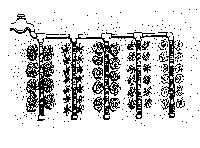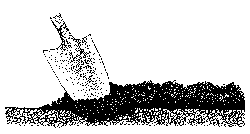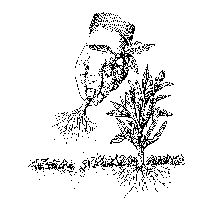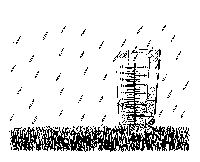|
Water-wise landscape design and management focus on working with nature and
natural forces (such as rainfall) to create an aesthetically pleasing, livablc
landscape, while using less water from the local supply.
Minimizing the need for watering in your landscape requires careful
observation, planning, and common sense. Several principles for water- wise
landscaping include choosing the best design and plants, preparing soils, and
watering properly for efficient water use.
Return to Table of Contents
The first step in any successful landscape is a good plan. Observe the site and
take notes on the current use of different areas or their desired use. Indicate
high-use areas, desirable views, environmental concerns (such as wind direction,
slopes, dense shade), and traffic flow through the yard. Sketch the property,
including any permanent structures, trees, and shrubs that you plan to leave,
grass areas, driveways, and sidewalks.
Based on your notes, develop a plan that meets your needs for use,
appearance, and budget. Consider maintenance and water requirements in making
your decisions. For example, maintaining a high-quality lawn area for
entertaining will require frequent fertilizing and mowing, as well as high water
use. A more maintenance-free choice for get-togethers is a deck or patio, but
don't overdo the use of wood or concrete on your land. Leave plenty of
vegetative surface for rain to reach the soil and soak in; otherwise, runoff and
erosion problems are created. Whatever plan you develop, the cost can be
distributed over a period of time if you implement your design over several
years.
Return to Table of Contents
Good soil is the basis for healthy plants and optimum use of water. The key to
good soil is the addition of organic matter, such as compost. Sandy soil will
hold water and nutrients better if organic matter is incorporated. Clay will
absorb water faster, reducing runoff and erosion, if it is loosened with organic
matter. Incorporate approximately 2 to 3 inches of compost, shredded leaves, or
other fine organic material to the soil annually.
In locations with established trees and shrubs, it is difficult to
incorporate organic matter, but applying and maintaining a 2- to 3-inch layer of
an organic mulch (coarse leaves, shredded bark, pine needles, or wood chips)
will gradually improve the soil as the humic acid formed by the decomposing
material leaches into the ground.
Return to Table of Contents
Decide on the trees, shrubs, and ground covers for your water-wise landscape
based on their natural ability to grow well in your area. Select plants that do
well with little or no addition of water. Consider native plants as well as
introduced species for residential landscapes. Your local Extension agent and
nursery personnel can help you identify suitable plants for your location.
Limit plants with high water demands to small areas that can be watered
efficiently. Grouping plants by water requirements is one way to guard against
overwatering some plants and underwatering others.
In general, ground covers require less water than turfgrass, so replacing
some of your lawn with a ground cover will conserve water. If you have large
deciduous trees in your yard and want to reduce work and water, go natural-allow
leaves to accumulate as they would in nature. Plant a few understory shrubs
(such as azaleas and rhododendrons), a few understory trees (such as dogwood),
and quit raking!
Return to Table of Contents
Use mulch to conserve soil moisture. Organic mulches help retain moisture so
there is less need to water. They also recycle plant materials that might
otherwise end up in the landfill. In addition, mulches control annual weeds that
compete with desired plants for water. Organic mulches improve soil structure as
they decompose and moderate the soil temperature, two factors that also help
plants use water efficiently.
Return to Table of Contents
Proper mowing and fertilizing of the lawn help conserve moisture. Mowing at the
proper height (do not remove more than one third of the grass at any one mowing)
allows the grass to develop deeper roots that are more efficient in using soil
moisture, and reduces annual weeds. Fertilizing at the proper time (your
Extension agent or local nursery experts can help you determine this) encourages
healthier turf that needs less watering.
Leaving shrubs in their natural forms reduces stress to the plants and.
therefore, lessens their need for water.
Keeping weeds, insects, and diseases under control reduces the competition
and stress to plants that increase their water demands.
These principles minimize the water demands in your landscape, help you save
money and time, and reduce your impact on the local water supply.
Return to Table of Contents
Limit the amount of turfgrass you use in the landscape to areas in which grass
provides a functional benefit (i.e., a play area for children) that exceeds the
benefit of other ground covers or surfacing materials. Select turfgrass suitable
to your climate and site.
Design the grass area to make watering easier. Long, narrow areas and small,
odd shapes are hard to water efficiently. Avoid turf in the strip between the
sidewalk and the road; most irrigation water will land on the paved surfaces and
run off.
Return to Table of Contents
While soils vary greatly in their ability to hold water, your garden and lawn
should receive enough water to wet the soil to the bottom of the root zone each
time you water-generally 1 inch per week. Determine this by digging a hole 5 to
6 inches deep in the watered area the day after watering so the water has a
chance to seep in. Adjust weekly watering to your soil needs.
Avoid watering by hand-it often wastes water as there is excess
runoff, and water does not penetrate beyond the top 1 inch of soil. This
irrigation practice harms plants by forcing root growth too close to the
surface. If you must water by hand, place a 5-gallon bucket with a few holes in
the bottom next to the plant and fill it with water; when it is has drained,
move it to the next plant and refill.
 Properly used sprinkler systems can deliver a large quantity of water
in a short time. They have the disadvantage, however, of excessive evaporation,
both during watering and from the plant and soil surface. Early morning watering
minimizes water loss. However, sprinkler systems that deliver the water from
overhead are the most effective means of watering turfgrass. Be sure to position
sprinklers to shower areas of vegetation, not driveways, streets, or patios.
Water until the soil is moist 6 inches deep, usually 1 inch per week applied at
one time. Properly used sprinkler systems can deliver a large quantity of water
in a short time. They have the disadvantage, however, of excessive evaporation,
both during watering and from the plant and soil surface. Early morning watering
minimizes water loss. However, sprinkler systems that deliver the water from
overhead are the most effective means of watering turfgrass. Be sure to position
sprinklers to shower areas of vegetation, not driveways, streets, or patios.
Water until the soil is moist 6 inches deep, usually 1 inch per week applied at
one time.
Trickle or drip irrigation systems and ooze hoses are very efficient,
slowly applying water to vegetable and ornamental gardens. Soil moisture can be
maintained at a level most suitable to plant uptake. If properly installed and
maintained, little water is lost to evaporation or runoff and water use can be
reduced by up to 50 percent. For many situations, the expense of installing a
good- trickle irrigation system will be compensated by reduced water usage, less
replacement of plant materials, and less work. On any irrigation system, replace
leaky parts promptly.
Return to Table of Contents
To measure the amount of water come from a sprinkler or rain-use a rain
gauge or a tin can set in the lawn or garden area to be measured. The soil has
received an inch of water when the water in the container is an inch deep.
Return to Table of Contents
| |


Conserve &
Protect our Natural Resources !
|
![]() Gardeners' Corner
Kids'
Garden
Sustainable Garden
Contact Us
Gardeners' Corner
Kids'
Garden
Sustainable Garden
Contact Us![]()


 Properly used sprinkler systems can deliver a large quantity of water
in a short time. They have the disadvantage, however, of excessive evaporation,
both during watering and from the plant and soil surface. Early morning watering
minimizes water loss. However, sprinkler systems that deliver the water from
overhead are the most effective means of watering turfgrass. Be sure to position
sprinklers to shower areas of vegetation, not driveways, streets, or patios.
Water until the soil is moist 6 inches deep, usually 1 inch per week applied at
one time.
Properly used sprinkler systems can deliver a large quantity of water
in a short time. They have the disadvantage, however, of excessive evaporation,
both during watering and from the plant and soil surface. Early morning watering
minimizes water loss. However, sprinkler systems that deliver the water from
overhead are the most effective means of watering turfgrass. Be sure to position
sprinklers to shower areas of vegetation, not driveways, streets, or patios.
Water until the soil is moist 6 inches deep, usually 1 inch per week applied at
one time.


